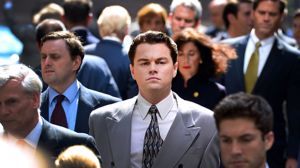Well this is quite the thing, isn’t it? After living a life of remorseless debauchery, having swindled untold thousands, getting busted, serving time, and then documenting it all in the inevitable tell-all book, you now find yourself the focus of a Martin Scorsese film! You could even say that you’re the hero of the piece, since your onscreen alter ego (played by Leonardo DiCaprio) appears in almost every scene.
If you believe some of the critical reaction, it would also seem that this is exactly what’s wrong with The Wolf of Wall Street. Here is a film that shows the worst of…well, pretty much everything—yet offers no judgment, establishes no true north on the moral compass so that audiences can guide themselves through the despicable proceedings. Scorsese even goes so far as to cast you in a small role. Is this a tip of the hat to you? Are the filmmakers tacitly approving your actions?
It’s a ridiculous argument. It assumes a level of knowledge about who you are that is unlikely for anyone who doesn’t do a little research beforehand (I only realized that you played the part while browsing the credits afterward). No, this extra-textual information has no bearing on the film itself. Let’s talk, instead, about what actually happens in The Wolf of Wall Street.
It’s an epic that exhaustively details your rise from wannabe Wall Street broker to president of a multi-billion dollar firm built on the pumping and dumping of penny stocks, primarily on those who can’t afford the losses. Profit-wise, Stratton Oakmont is pretty small-scale by Wall Street standards (the head office was in Long Island). But it afforded you enough to indulge in whatever depravity you could think up. And, boy, could you think up a lot. This is a slimy story, told about (and with, and by) pure adrenaline.
Scorsese and screenwriter Terence Winter show their hand right away. Instead of starting chronologically with your early, earnest years, they cut right to you at your hedonistic, self-satisfied worst—all described in an energetic DiCaprio voice-over. It not only prepares the audience for what’s to come, but also serves as a kind of advanced warning: with you as our only guide, we’re going to have to do the heavy lifting when it comes to interpreting what we see. It’s a lot to ask of an audience. It’s also incredibly entertaining.
That’s the thing with The Wolf of Wall Street—it doesn’t pretend that these aren’t charismatic, funny characters. And the casting further stacks the deck: Dicaprio, Jonah Hill, Rob Reiner, and Matthew McConaughey (in a small role that is essentially a masturbation-obsessed version of Alec Baldwin’s “Man from Downtown” in Glengarry Glenross). And after DiCaprio (i.e. you) dumps his first wife in favour of a younger, blonder model (Margot Robbie), few characters are left to earn our sympathies. Only Kyle Chandler, as an FBI investigator, provides any sort of navigation, and his straight-arrow life is shown to be pretty miserable.
The Wolf of Wall Street is funny. Really funny. More than once I found myself horrified at the antics at which I was laughing out loud. A mid-film set piece that involves a late night ride to the country club and far too many quaaludes is the funniest scene I've seen all year. DiCaprio showcases a heretofore unknown, Tati-like knack for physical comedy.
But Scorsese’s been around this block before. He knows enough about the charisma of powerful, terrible men to allow himself to be seduced by it. As The Wolf of Wall Street passes the two-hour mark, it becomes a lot less fun. Not because the characters aren’t enjoying themselves – I’m sure you were still quite happy with your life – but the unceasing repetition becomes numbing: drug-fuelled orgies become boring; foul-mouthed motivational speeches feel stale, by-the-numbers. While it’s not the most fun for an audience, it’s all by Scorsese’s, (and Winters’ and editor Thelma Schoonmaker’s) design. An audience needs to get sick of you and your near-sociopathic cronies to gain any sort of context. It’s how the audience finally gets free of your twisted point of view.
And that’s what it really boils down to in The Wolf of Wall Street: it’s told through your eyes. Every time Scorsese sneaks in a genuine shock (say, a crime scene photograph of a broker’s suicide) you’re there to brush it aside with a quick “Anyway…” The filmmaker’s voice is constantly fighting against yours, which is what ultimately makes the picture so remarkable.
As much as you may have thought you owned the world, this isn’t really your movie, is it? It’s Scorsese’s, and he gets the last word. In that final scene, when you make your cameo, the final shot of the film implicates not only you, but all of us. That’s The Wolf of Wall Street’s last and best joke: that the victims want you to keep conning them so they might someday learn how to con someone else.
(Hopefully) seeing it clearly,
Casey







